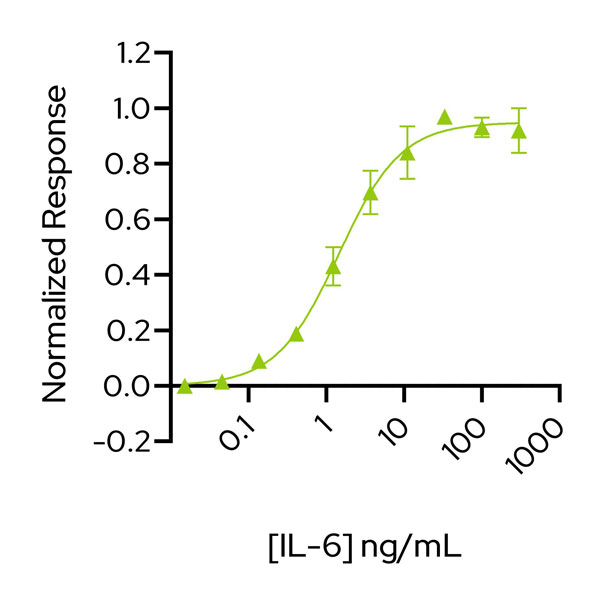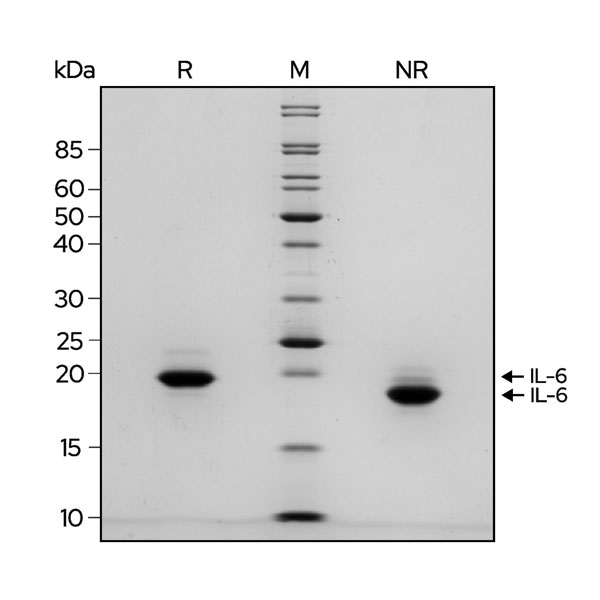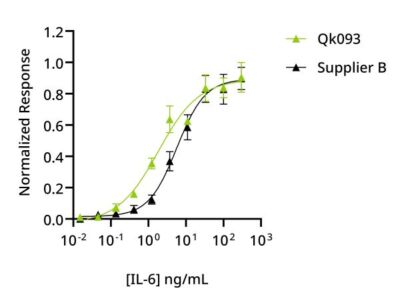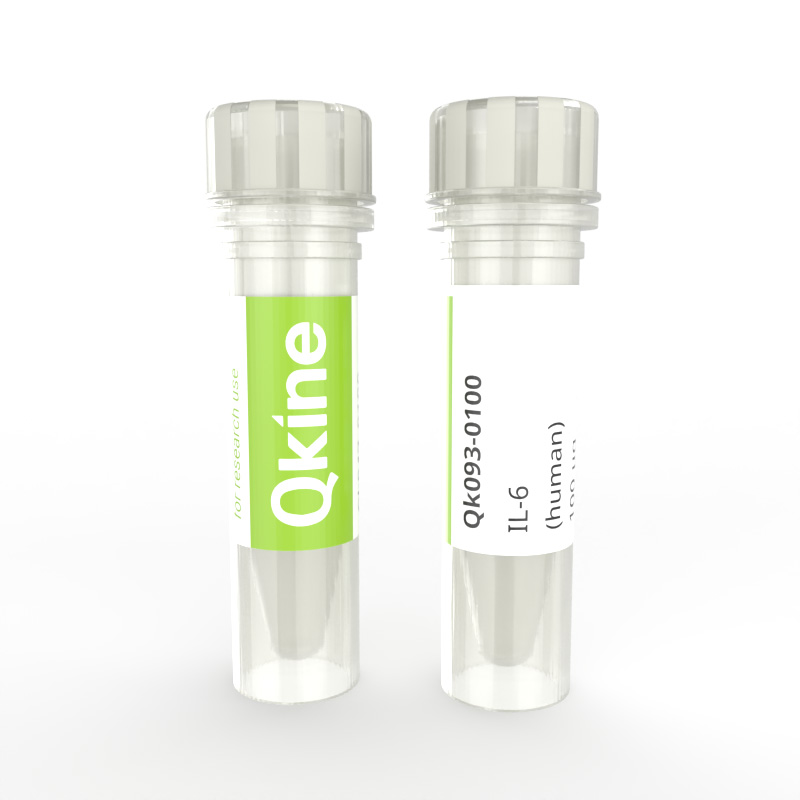Currency
Recombinant human IL-6 protein (Qk093)
Interleukin-6 (IL-6) is a multifunctional cytokine that regulates immune responses and inflammation. It is produced by various cells, including immune cells such as T cells and macrophages, as well as non-immune cells like fibroblasts and endothelial cells.
Human IL-6 has a molecular weight of 20.9 kDa. This protein is animal origin-free, carrier-free and tag-free to ensure its purity with exceptional lot-to-lot consistency. IL-6 is suitable for the culture of reproducible and high-quality hematopoietic stem cells and other relevant cells.
Orders are typically shipped same or next day (except Friday).
Easy world-wide ordering, direct or through our distributors.
1000µg will be despatched as 2 x 500µg
Fast and free shipping.
Buy online with secure credit card or purchase order.
For any questions, please email orders@qkine.com
Summary
High purity human protein (Uniprot number: P05231)
>98%, by SDS-PAGE quantitative densitometry
Source: Expressed in E. coli
20.9 kDa monomer
Animal origin-free (AOF) and carrier protein-free
Manufactured in Cambridge, UK
Lyophilized from HEPES/NaCl
Resuspend in water at >100 µg/mL, prepare single-use aliquots, add carrier protein if desired, and store frozen at -20oC or -80oC
Featured applications
Immune response regulation
Stimulation of B cell differentiation
Stimulation of T cell differentiation
Hematopoiesis regulation
Proliferation and differentiation of erythrocytes, leukocytes and platelets
Inflammation amplification
B-cell stimulatory factor 2 (BSF-2)
CTL differentiation factor (CDF)
Hybridoma growth factor
Interferon beta-2 (IFN-beta-2)
Human
Bioactivity

IL-6 protein activity is determined using the IL-6-responsive firefly luciferase reporter assay. Transfected HEK293T cells are treated in triplicate with a serial dilution of IL-6 for 24 hours. Firefly luciferase activity is measured and normalised to the control Renilla luciferase activity. Data from Qk093 lot #204594. EC50 = 1.46 ng/mL (70 pM)
Purity

Recombinant IL-6 migrates as a major band at approximately 20 kDa in non-reducing (NR) and at approximately 18 kDa in reduced (R) conditions. No contaminating protein bands are present. The purified recombinant protein (3 µg) was resolved using 15% w/v SDS-PAGE in reduced (+β-mercaptoethanol, R) and non-reduced (NR) conditions and stained with Coomassie Brilliant Blue R250. Data from Qk093 lot #204599.
Further quality assays
Mass spectrometry, single species with the expected mass
Endotoxin: <0.005 EU/μg protein (below the level of detection)
Recovery from stock vial: >95%
We are a company founded and run by scientists to provide a service and support innovation in stem cell biology and regenerative medicine. All our products are exceptionally high purity, with complete characterisation and bioactivity analysis on every lot.
Qkine IL-6 is more biologically active than a comparable alternative supplier protein

Quantitative luciferase assay with Qkine IL-6 (Qk093, green) and alternative supplier IL-6 (Supplier B, black). Cells were treated in triplicate with a serial dilution of IL-6 for 24 hours. Firefly luciferase activity was measured and normalized to control Renilla luciferase activity. Qk093 EC50 1.85 ng/ml, Supplier B EC50 5.74 ng/ml.
Protein background
Interleukin-6 (IL-6) is a multifunctional cytokine that plays a crucial role in regulating the immune response, inflammation, and various physiological processes. IL-6 is produced by a variety of cells, including T cells, B cells, monocytes, fibroblasts, endothelial cells, and adipocytes [1].
IL6 protein is a pleiotropic cytokine that belongs to the interleukin family of proteins. IL-6 adopts a four-helix bundle structure, with helices A and D forming the receptor-binding site [2]. It is glycosylated, influencing stability and activity. IL-6 binds to IL-6 receptor (IL-6R), forming a hexameric complex with gp130, initiating downstream signaling via the JAK/STAT pathway. Conformational changes upon receptor binding facilitate signaling.
IL-6 has a primary involvement in the acute phase response, the immediate reaction to infection, injury, or inflammation. IL-6 stimulates the production of acute-phase proteins such as C-reactive protein (CRP), fibrinogen, and serum amyloid A, which help to enhance the immune response and facilitate tissue repair [3,4].
IL6 protein plays a key role in the regulation of the immune system. It promotes the differentiation of B cells into antibody-producing plasma cells and stimulates the proliferation and activation of T cells, enhancing the adaptive immune response. IL-6 acts on various immune cells to modulate inflammation, promoting the recruitment of immune cells to sites of infection or injury [5,6]. IL-6 has diverse effects on different tissues and organs throughout the body. It has been implicated in the regulation of metabolism, with studies suggesting that IL-6 may play a role in energy balance, glucose metabolism, and lipid metabolism. IL-6 has been shown to have both pro- and anti-inflammatory effects depending on the context and the cells involved [7].
Dysregulated IL-6 signaling has been associated with various pathological conditions, including autoimmune diseases, chronic inflammation, and cancer. Elevated levels of IL-6 have been observed in conditions such as rheumatoid arthritis, systemic lupus erythematosus, and inflammatory bowel disease, where it contributes to tissue damage and disease progression [8].
Our products are for research use only and not for diagnostic or therapeutic use. Products are not for resale.



What others are saying
There are no contributions yet.